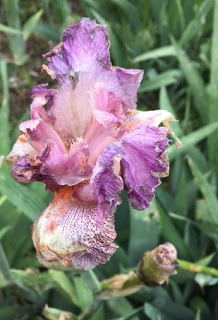This photo is of the low-growing Catclaw Sensitive Briar (Mimosa quadrivalvis), a member of the Fabaceae (or Bean family), so named because of the prickly pods that catch exposed ankles as you walk by, and for the delicate leaflets that fold when touched. It has a long bloom period and can be seen blooming over most of May and June.Of similar color, the Illinois Tickclover (Desmodium illinoense) is another Fabaceae, taller and more sparsely represented on my spot of prairie. Late in the summer, the mature seedpods of this plant cling to my pants and hitchhike wherever I walk, often causing me to sit and pick at my pant-legs for a long time before they get washed.
These Echinacea are abundant in my area, and are favorites of local butterflies, bees, and finches.
 I've posted a photo before of the Fringe-Leaf Ruellia (Ruellia humilis), but didn't write much about it. It grows freely, low to the ground, in both the mowed areas of the yard and in the taller native prairie. I have it stuck in my head that Ruellia is a violet of some type and I have to correct myself each time I see and identify it.
I've posted a photo before of the Fringe-Leaf Ruellia (Ruellia humilis), but didn't write much about it. It grows freely, low to the ground, in both the mowed areas of the yard and in the taller native prairie. I have it stuck in my head that Ruellia is a violet of some type and I have to correct myself each time I see and identify it.
There are many forms of Asteraceae, composite flowers of the Sunflower family, that bloom and attract native insects and birds on the prairie. Daisy Fleabane (Erigeron strigosus) is one of those, 2-3 feet tall and easily visible among the grasses. It does not, contrary to myth, repel fleas from man nor from beast.
Another Asteraceae member presently blooming are the Black-Eyed Susan (Rudbeckia hirta). This gray-green, hairy-leafed plant doesn't compete well with prairie grasses, but it sprouts willingly on disturbed ground. If I showed you a picture of my vegetable garden right now, you'd think I was growing it preferentially there (which I do, since I don't weed it out unless it is adjacent to a tomato, zucchini, or other intentional planting.
The prairie is awash right now with clumps of Wild Alfalfa (Pediomelum tenuiflorum), providing some blue tones to contrast with the yellows and whites. If you view the flowers up close, you can see why this plant is placed in the Bean family.
 I've posted a photo before of the Fringe-Leaf Ruellia (Ruellia humilis), but didn't write much about it. It grows freely, low to the ground, in both the mowed areas of the yard and in the taller native prairie. I have it stuck in my head that Ruellia is a violet of some type and I have to correct myself each time I see and identify it.
I've posted a photo before of the Fringe-Leaf Ruellia (Ruellia humilis), but didn't write much about it. It grows freely, low to the ground, in both the mowed areas of the yard and in the taller native prairie. I have it stuck in my head that Ruellia is a violet of some type and I have to correct myself each time I see and identify it.There are many forms of Asteraceae, composite flowers of the Sunflower family, that bloom and attract native insects and birds on the prairie. Daisy Fleabane (Erigeron strigosus) is one of those, 2-3 feet tall and easily visible among the grasses. It does not, contrary to myth, repel fleas from man nor from beast.
Another Asteraceae member presently blooming are the Black-Eyed Susan (Rudbeckia hirta). This gray-green, hairy-leafed plant doesn't compete well with prairie grasses, but it sprouts willingly on disturbed ground. If I showed you a picture of my vegetable garden right now, you'd think I was growing it preferentially there (which I do, since I don't weed it out unless it is adjacent to a tomato, zucchini, or other intentional planting.
I could, and should, show you photos a few dozen clumps of Butterfly Weed (Asclepias tuberosa). This unmatched bright-orange color uniquely stands out in the grasses and I encourage it to grow and seed wherever it chooses on the prairie or even in my garden beds.
One thing about Asclepias, it draws butterflies and bees from everywhere. I really should start learning to identify bees and wasps so that I can recognize and encourage either of these visitors to my prairie.
Click on this picture to expand it and you'll see both a butterfly and a bee on the upper left of this single spray. I'm not sure, but the butterfly here is perhaps a Pearl Crescent (Phyciodes tharos), common in my area.
Last, but not least for a gardener who is always looking for roses, I'll show you a closeup of Rosa arkansana, the Prairie Wild Rose. R. arkansana is a low-growing, once blooming, winter-hardy rose that has been used in the breeding programs of Ag Canada. It is everywhere on the prairie, food for insects and animals alike.
And now, what characteristic do all these have in common? Along with also-currently-blooming but unpictured Lead Plant (Amorpha canescens), Waxy-Leaf Thistle (Cirsium undulatum), White Prairie Clover (Dalea candida) and Purple Prairie Clover (Dalea purpurea) and Woolly Verbena (Verbena stricta)? All of these are drought resistant natives, stoic in the face of the fickle prairie rains. They hold a hidden message of hope for the gardener; "for best results, choose drought-resistant perennials and shrubs!!!!"
.jpg)
.jpg)
.jpg)
.jpg)

.jpg)
.jpg)

.jpg)
.jpg)

%201.jpg)

.jpg)
.jpg)
.jpg)
.jpg)

.jpg)
.jpg)
.jpg)


.jpg)
.jpg)
.jpg)
.jpg)





















.jpg)
.jpg)
.jpg)
.jpg)